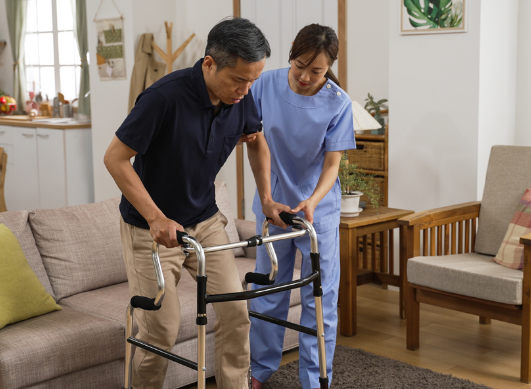How to recognize the signs of a stroke ?
Published Dec 26, 2019 • By Camille Dauvergne
Every year in the US, more than 140 000 people suffer a stroke and thousands die from it; with the case numbers constantly increasing. Strokes are also the leading cause of long-term disability in the US. Still, if a stroke is recognized in time, it may be possible to improve the chances of survival and lower the risk of handicap-inducing side effects.

What is a stroke?
Stroke is the sudden loss of brain function when blood flow is cut off inside the brain. There are two possible causes of blood flow loss:
- - In 80% of cases, a blood cot is blocking an artery in the brain; this is called an ischemic stroke.
- - In 20% of cases, the stroke occurs when an artery bursts, provoking severe bleeding in the brain; this is called a hemorrhagic stroke.
When blood flow is cut off, insufficient oxygen and nutrients reach the brain, and brain cells begin to die off in the affected zone. The severity of a stroke depends on where in the brain it occurs, how many zones within the brain are affected and the delay between onset and treatment by medical professionals.
Why faster is better
Unfortunately, a stroke is capable of causing irreversible brain damage if it's not caught in time. It's generally agreed that for best results a stroke victim should be checked into a neurovascular service within the first few hours following the onset of symptoms if one hopes to limit irreversible damage. The quicker a stroke patient is taken into care, the more effective the treatment will be and the fewer side effects the patient will suffer. This is why it's so important to give the public the tools to recognize a stroke as this will allow victims to access treatment as quickly as possible.
Today, in certain areas, such as large cities, treatment for strokes is widely available and quick, less than an hour on average, if emergency services are called as soon as symptoms appear. In more rural regions, however, this is often not the case.
How to recognize the symptoms of a stroke
Given the consequences of not treating a stroke in time, it's very important to know how to recognize the symptoms. Although the symptoms can vary, (depending on the exact location of the blockage), some are more common than others:
- - Muscular weakness or paralysis in the limbs, hands, or face, often on only one side of the body (Hemiplegia)
- - Loss of feeling or numbness in the limbs, hands or face
- - Loss of sight in one eye or half of the field of vision in both eyes
- - Speech difficulties: trouble pronouncing or remembering words and/or difficulty understanding the speech of others
- - Loss of balance or loss of coordination
- - Loss of alertness which can eventually deteriorate to a state of coma
- - Headaches that are sudden, intense and out of the ordinary
The sudden onset of the above symptoms, even if they seem to ease after a few minutes, should be cause for alarm!
Questions to ask someone you think may be having a stroke
If you are with someone who seems disoriented, confused or who appears to be paralyzed on one side of the body, try to ask the following three questions:
- - "Can you lift both arms up to the same height?" while miming the gesture for the person >> if they are unable to lift one of their arms to the same level as the other, the person may be suffering a stroke.
- - "Can you repeat after me: 'Fine weather we're having today.'?" >> if the person's response is garbled or incomprehensible, they may be having a stroke.
- - "Can you tell me what day it is today? What month? What year?" >> if the person seems confused or unable to answer, they may be having a stroke.
What should you do if you spot the symptoms?
If you observe one or more of the above symptoms in someone, call 911 immediately and tell the operator about the symptoms you observed. If you experience any of the above symptoms yourself, call 911 immediately. Better safe than sorry!
Transient Ischaemic Attacks: an alarm signal you shouldn't ignore
Sometimes, a clot that is blocking blood flow may dislodge itself on its own, this is called a Transient Ischemic Attack (TIA). When this happens, stroke symptoms may manifest in a patient, but only for a few minutes. Or, a TIA may be completely asymptomatic or confused with a fainting spell. However, stroke risk is particularly high in the hours and days immediately following a TIA (5% chance of stroke within 48h and 10% within a month). If you or someone you know suffers a TIA, you should consult a physician immediately!
Stroke risk factors that you can reduce
Identifying and reducing the risk factors most commonly responsible for strokes helps reduce the risk of having one. Some of the most common risk factors include:
- - Diabetes
- - High blood pressure
- - Smoking
- - Being overweight or obese
- - A sedentary lifestyle (lack of physical activity and/or exercise)
- - Alcohol consumption
Get regular bloodwork done, keep an eye on your blood sugar levels and blood pressure in particular, reduce your consumption of tobacco and alcohol and make sure to get enough exercise and eat a balanced diet.
Warning: This article is a general overview and does not replace medical advice given by a health-care professional. It does not take into account individual patient cases which may vary. Each patient is different, always take your physician before beginning or altering your treatment!

 Facebook
Facebook Twitter
Twitter




